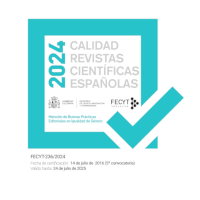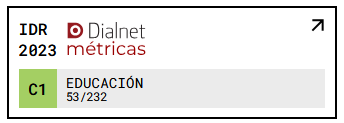Treatment of the concept of angle in elementary school textbooks in Chile
DOI:
https://doi.org/10.18172/con.5149Keywords:
Geometry, basic education, Primary school teacher, Mathematics education, Public educationAbstract
For the work of this article, the mathematical object angle and its progression in primary school textbooks of the Chilean educational system, which are delivered free of charge to schools that receive state resources, were analyzed. The activities, solved exercises and proposed situations were classified into various categories according to their definition, meaning and associated difficulties. The results show a marked tendency to show the angle as a pair of rays with a common point in a static sense, which brings various difficulties, among which those that exclude some angle measurements such as 0°, 180°, stand out mainly. 360 °, negative angles and those that have a measure greater than 360°. It is concluded that one of the ways to avoid these difficulties is to work this object with a dynamic meaning, in systems with an initial beam and a final beam that rotates to form the desired angle, without excluding those already mentioned and thus avoiding generating difficulties in internalization. of this concept by the students.
Downloads
References
Andonegui, M. (2006). Geometría: conceptos y construcciones elementales. Federación Internacional Fe y Alegría.
Aravena, M. y Caamaño, C. (2013). Niveles de razonamiento geométrico en estudiantes de establecimientos municipalizados de la región del maule. Talca, Chile. Revista Latinoamericana de Investigación en Matemática Educativa, 16(2), 139-178. https://doi.org/10.12802/relime.13.1621 DOI: https://doi.org/10.12802/relime.13.1621
Arias, P. (2020). Análisis resultados Timss 2019. Acción Educar, 1. 1-6. https://accioneducar.cl/analisis-resultados-prueba-timss-2019/
Browning, C., Garza-Kling, G. y Sundling, E. (2007). What’s your angle on angles? Teaching Children Mathematics, 14(5), 283-287. DOI: https://doi.org/10.5951/TCM.14.5.0283
Buendia, G. (2011). Reflexión e Investigación en Matemática Educativa. Lectorum.
Casas, L. y Luengo, R. (2005). Conceptos nucleares en la construcción del concepto de ángulo. Enseñanza de las ciencias, 23(2), 201-216. https://raco.cat/index.php/Ensenanza/article/view/22018 DOI: https://doi.org/10.5565/rev/ensciencias.3842
Díaz, L. y Kú, D. (2017). Construcción del concepto de ángulo en segundo grado de secundaria desde la teoría Apoe. Investigación e Innovación en matemática educativa, (2). 436-445.
Fyhn, B. (2007). A Climbing Class’ Reinvention of Angles. Educational Studies in Mathematics, 67(1), 19-35. https://doi.org/10.1007/s10649-007-9087-z DOI: https://doi.org/10.1007/s10649-007-9087-z
Hilbert, D. (1950). The foundations of Geometry. (L. Unger, Trans.) (2nd. ed.). La Salle, Open Court. https://math.berkeley.edu/~wodzicki/160/Hilbert.pdf
Hurtado, L. (2017). Revisión de las definiciones de proposición y enunciado en su relación con las matemáticas. Revista digital de investigación en docencia universitaria, 11(1), 207-218. http://www.scielo.org.pe/pdf/ridu/v11n1/a14v11n1.pdf DOI: https://doi.org/10.19083/ridu.11.481
Husserl, E. (2000). El origen de la geometría. Manantial.
Itzcovich, H. (Ed.) (2007). La matemática escolar. Aique.
Itzcovich, H. (2005). Iniciación al estudio didáctico de la Geometría. Zorzal.
Matos, J. (1991). The historical development of the concept of angle (2). The Mathematics Educator, 2(1), 18-24.
Matos, J. (1990). The Historical Development of the Concept of Angle. The Mathematics Educator, 1(1), 4-11.
Mitchelmore, M. y White, P. (2000). Development of Angle Concepts by Progressive Abstractions and Generalization. Educational Studies in Mathematics, 41, 209-23. https://doi.org/10.1023/A:1003927811079 DOI: https://doi.org/10.1023/A:1003927811079
Ministerio de Educación (2020). Texto del estudiante Matemática. Santillana.
Ministerio de Educación (2018). Bases curriculares. https://www.curriculumnacional.cl/614/articles-22394_bases.pdf
Munier, V. y Merle, H. (2009). Interdisciplinary Mathematics-Physics Approaches to Teaching the Concept of Angle in Elementary School. International Journal of Science Education, 31(14), 1857-1895. https://doi.org/10.1080/09500690802272082 DOI: https://doi.org/10.1080/09500690802272082
Pachuca, Y. y Zubieta, G. (2020). Definiciones e imágenes del concepto de ángulo y su medida en estudiantes que inician la educación superior. Educación Matemática, 32(1), 38-66. https://doi.org/10.24844/EM3201.03 DOI: https://doi.org/10.24844/EM3201.03
Pino J., y Blanco. J. (2008). Análisis de los problemas de los libros de texto de matemáticas para alumnos de 12 a 14 años de edad de España y de chile en relación con los contenidos de proporcionalidad. Publicaciones, 38, 63-88. https://revistaseug.ugr.es/index.php/publicaciones/article/view/2247
Rotaeche, R. y Montiel G. (2017). Aprendizaje del concepto escolar de ángulo en estudiantes mexicanos de nivel secundaria. Educación Matemática, 29(1), 171-199. https://www.redalyc.org/pdf/405/40550442008.pdf DOI: https://doi.org/10.24844/EM2901.07
Rotaeche, A. y Montiel, G. (2008). From the History of the Angle to its Epistemological Nature. Contributions to a Scholar Design. Proceedings of the Conference History and Pedagogy of Mathematics 2008. https://www.researchgate.net/publication/237437592_FROM_THE_HISTORY_OF_THE_ANGLE_TO_ITS_EPISTEMOLOGICAL_NATURE_Contributions_to_a_scholar_design
SIMCE (2019). Resultados Nacionales SIMCE. http://archivos.agenciaeducacion.cl/PPT_Nacional_Resultados_educativos_2019.pdf
Torres, Y. y Moreno, R. (2008). El texto escolar, evolución e influencias. Laurus, 14(27), 53-75. https://www.redalyc.org/pdf/761/76111892004.pdf
Vinner, S. (2002). The role of definitions in the teaching and learning of mathematics. En D. Tall (Ed.), Advanced Mathematical Thinking (pp. 65-81). Kluwer Academic Publishers. DOI: https://doi.org/10.1007/0-306-47203-1_5
Downloads
Published
How to Cite
Issue
Section
License
Copyright (c) 2022 Romi Alejandra Torres Díaz, Mario Arturo Sanchez Bustos

This work is licensed under a Creative Commons Attribution 4.0 International License.
The authors retain copyright of articles and authorize Contextos Educativos. Revista de Educación the first publication. They are free to share and redistribute the article without obtaining permission from the publisher as long as they give appropriate credit to the editor and the journal.
Self-archiving is allowed too. In fact, it is recommendable to deposit a PDF version of the paper in academic and/or institutional repositories.












